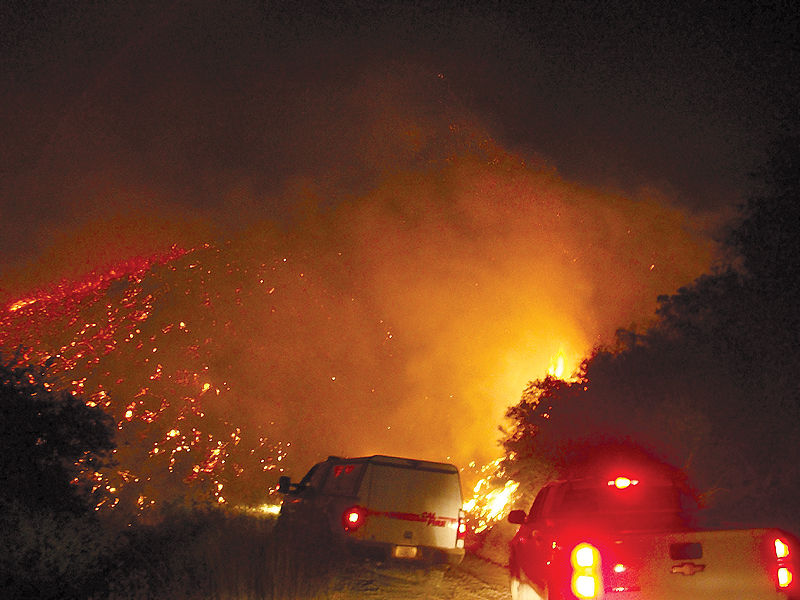For the middle two weeks of December, fire fighters from Utah were fighting blazes in California. While most of those involved in the endeavor were from the large northern Utah fire departments, and they were the ones that got the press coverage, a number of personnel from other places in Utah were on the lines.
“There were engines from the northern to the southern part of Utah there,” said Price Fire Chief Paul Bedont a few days after he and others returned from the operations there. “Price Fire was part of the Central Utah Strike team. Those on that team were mostly central and eastern Utah fire fighters. From our area was Justin Needles, Jeremy Jorgensen and myself. There were also two from Emery County.”
The fire departments and other agencies that went to California are involved in a reciprocal pact that is in place between Utah and other states, including California. The Emergency Mutual Aid Compact says when another state needs help, those in the agreement will respond with whatever they can to aid in the emergency. An memorandum of understanding exists with the state of Utah that covers all the local agencies that join in on an operation.
“The pact is set up so that all the costs of the responding agencies are covered,” said Bedont. “It is billed through the state so that individual departments do not have to deal with it. This compact makes it easy to ship resources back and forth when needed. We actually work under our state contract when we do this type of thing.”
Bedont said that most of the work the fire fighters from this area did was mop up in areas where flare ups occurred after the main blaze had passed.
“They stop the fire at a certain point and then they go on to stop it somewhere else,” he said. “Then they have a team like ours go in and spend time in the area where the fire was to keep those flare ups down.”
At first the team was assigned to the Lilac Fire near Camp Pendleton. Bedont said that they got to see some of the devastation and it was unbelievable.
“At one point we spent the better part of a day with a avocado rancher whose orchard had burned,” he explained. “Once that was under control we spent a day in staging. At that point they made arrangements for us to go to the Thomas Fire (north of Los Angeles).”
With that fire for part of the time they were doing “burns on the front” said Bedont.
Battle for control
“This is a little different than fighting normal fires,” he stated. “You just get way ahead of the fire and try to burn out areas.”
The only way it could be managed is to try and reign it in. Bedont said that there were 67 bulldozers on the fire breaking fire lines.
“They would have these dozers cut lines and then we would burn away from these lines to create a buffer space,” he said. “The other thing is the air resources that Cal Fire has that they have to fight fires is huge. I think California must have more planes than the Air Force.”
One morning they were in a staging area in Montecido and he said they were waiting for the fire front to come through because the meteorologists had predicted 60 to 70 mile an hour winds coming from the east. These winds are referred to as the Santa Ana winds.
“We were assigned to what they call a fire following,” said Bedont. “That is once the fire front went through an area we would go in and try to mop up anything that is flaring up or if there is a home for instance we would try to save what we can. There is no way you can stay in front of these fires so you follow up on them.”
He said they waited there all night long and then about 6 a.m. the winds came through.
Amazing magnitude
“The fire behavior was nothing like I had ever seen before,” he said. “Anything in the way could be threatened. They put crews at certain houses and when it came through everyone was just setting off back burns to try and keep it away from the structures. We were lucky. I think only one or two homes were lost in that area. I really thought they were going to lose the whole town, all of Montecido and Santa Barbara as well. The fire sounded like a freight train when it passed by. We’ve dealt with big fire here before, but never on this magnitude.”
The eastern and central Utah strike team stayed together during the fire, using their personnel and the six engines they had brought with them. It was dubbed Central Utah Task Force 5.
He said that everyone was grateful to them for being there. He also said that 80 percent of the people that were walking down the streets had masks on.
“There was ash on everything and the heavy smoke was all over the place,” he stated. “The day we were released was actually the first clear day we saw.”
Local fire fighters return from California inferno

Vehicles head into the dragon’s den - the Thomas Fire. PHOTOS COURTESY OF PAUL BEDONT
